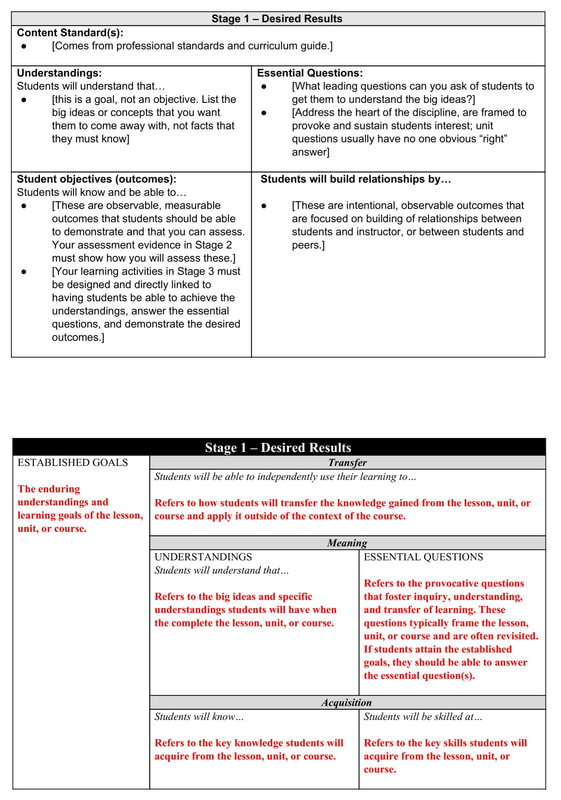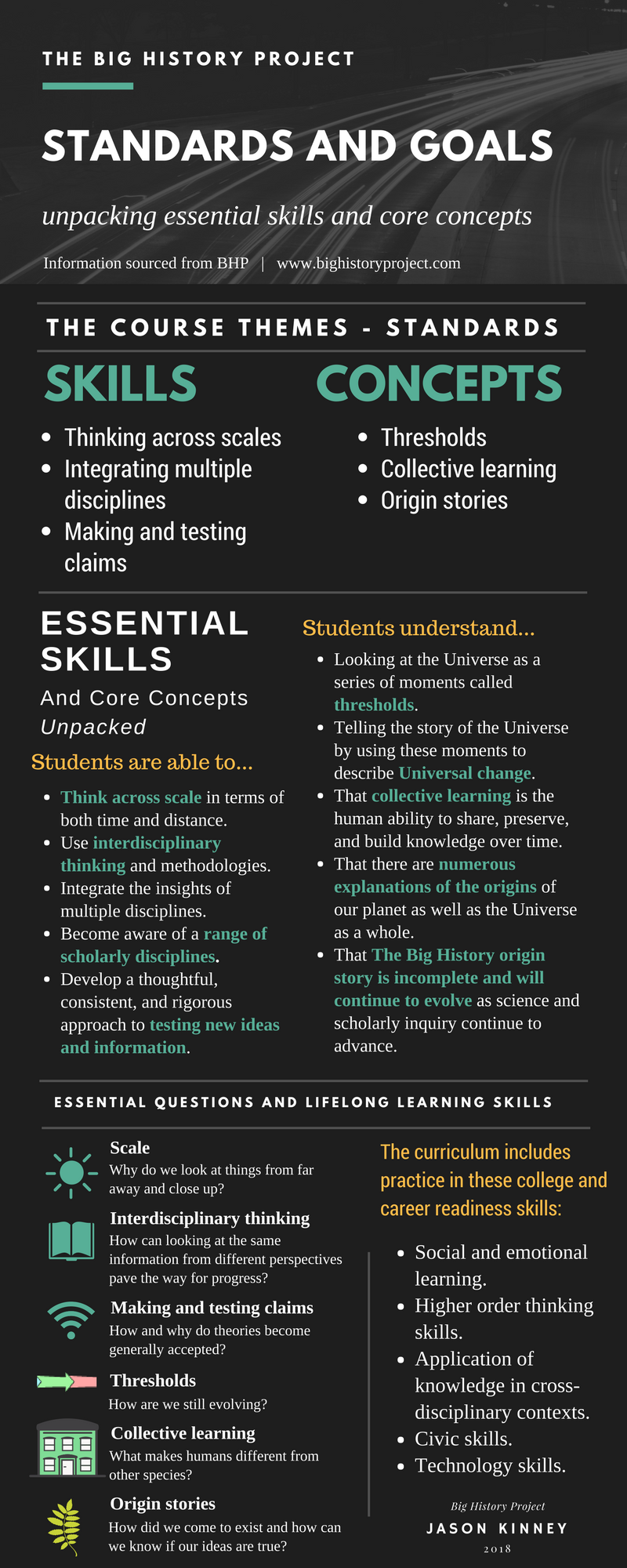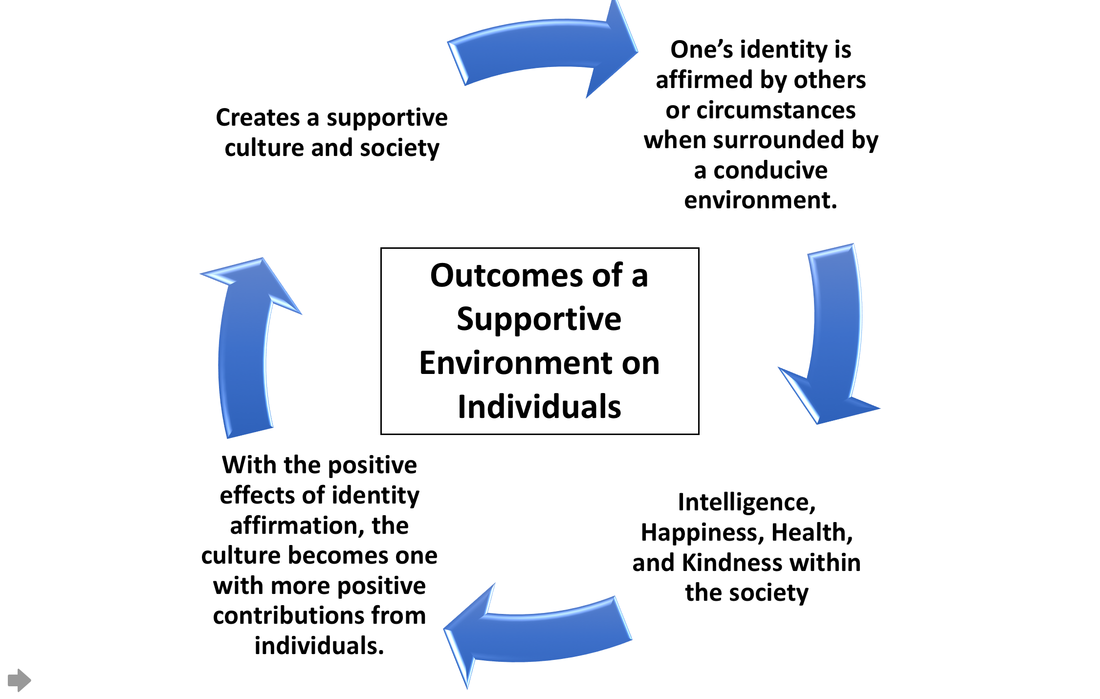| Unityoga.org |
stage one |
Identify Learning Outcomes: |
desired results
"Teachers are designers"
(WIGGINS & MCTIGHE, 2006)"Backward Design is goal directed. We aim for specific results and design backward from them accordingly"
|
Introduction:
The first stage of Backward Design is to identify what the student should be able to do, know, and understand upon completing the learning. This will depend upon content standards, course objectives, and desired learning outcomes. "We cannot say how to teach for understanding or which activities to employ until we identify which understandings we are after and what these understandings look like in practice. Only by identifying the chosen results can we focus on the content, methods, and activities most likely to achieve these results." (Wiggins & McTighe, 2006)
Examples of these readiness skills, for an example curriculum "The Big History Project" course, along with the associated standards, learning objectives, and "Essential Questions" to frame the learning for that course around, can be found in an infographic below the Stage One Planning Template Examples.
|
Backward design stage one templates |
Examples of Backward Design Lesson Plan Templates for Stage One, With Descriptions for Each Section:
Complete, downloadable lesson plan templates (Google Docs Format)
Infographic showing the Stage One components for "The Big History Project" course (as an example):
Example of a completed Stage One Lesson Template for The Big History Project:
| ||||||||||||
Essential Questions"a genuine understanding involves another kind of transfer. We go beyond what we see, using big ideas, to make meaning of it."(WIGGINS & MCTIGHE, 2006)"MEANING-MAKING OCCURS WHEN LEARNERS ARE GIVEN THE OPPORTUNITY TO CONSTRUCT THEIR OWN UNDERSTANDING AROUND BIG IDEAS AND ESSENTIAL QUESTIONS." |
Creating Understanding:
Understanding is about making connections and binding together our knowledge into something that makes sense. "To have understanding means that we show evidence of being able to transfer what we know." (Wiggins & McTighe, 2006). In order to focus on the "big ideas" that give meaning and connection to all the learned facts and skills, we can use essential questions to guide student inquiry and focus instruction. These are big overarching questions, centered on the standards and goals of understanding, that should be pursued and contemplated throughout the unit, course, or curriculum to help tie together all of the activities and learning in the learners mind. Five recommended criteria for writing good essential questions:
Wiggins and McTighe (2006) explain that questions are essential if they are meant to do the following:
Click Here for checklists from the Santa Ana Unified School District to help you assess whether or not you have created good essential questions see the lists on their Godinez Fundamental High School Website. The term “understanding” is such a complex idea that Wiggins and McTighe have delineated six facets of understanding as shown in this chart (2006). They describe understanding as the ability to explain, interpret, apply, have perspective, empathize and have self-knowledge of a concept. Click Here for a summary of the Six Facets. In order to develop real understanding, motivation is key. Essential questions can help motivate students by "connecting abstract learning to concrete situations", and allowing them to "Go deep into the subject." Watch the video below for insight into real motivation and then read the suggestions that follow. Motivating students by design:
A very important element of motivation as elucidated by Pink (2010) is "Purpose"; a sense of meaning for the task, job, or lesson. People want to feel like they are contributing to something bigger, like the work they do has relevance. One way to ensure that students have that sense of purpose in their studies is to always frame each lesson and unit into the real context in which that knowledge or understanding lives; be it the relevant career, societal function, even philosophical understanding or practical everyday life applications that follow. A great tool to use in providing that context while at the same time creating a challenge is an essential question. The right question can create a framework within which to explore the many ideas and perspectives that human knowledge and understanding is built upon. We can think of it like planting a seed. We cannot make someone interested in a subject or topic, the key is giving them that question, that seed of mystery... and letting them grow the tree of understanding from which will follow the fruit of intrinsic motivation. Here's a list from an online article by Paul (2013) that presents six ways to motivate students to learn:
building relationshipsIntentional relationship building opportunities:
According to the work done by Hattie (2009) and others, relationships between students and teachers as well as between students and their peers, have a large impact on the effectiveness of instruction. Therefore, it is important to identify opportunities amongst the course goals for collaboration and relationship building. Other Stage One Concerns:
Different schools or courses may require more focus on certain aspects of the first stage of Backward Design. One of the example templates above has a section to describe how the students will "transfer" their understandings and apply the learning outside of the context of the course. Whatever your particular curricular needs may be, it is suggested that "Designers should work smarter, not harder, by sharing curriculum designs with others" (Wiggins & McTighe, 2006). |
Continue to Stage Two for information about Adding Assessments to determine if the Goals have been met.
Backward Design Toolkit - navigation
|
Unityoga.org
one Y? one answer... |



